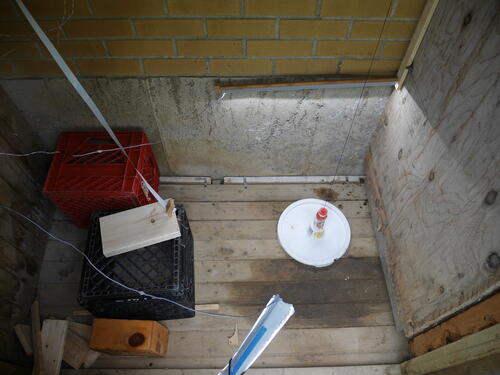
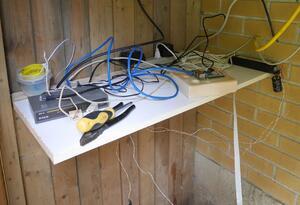 This experiment started with setting things up to eventually try
my conveyor belt maze.
But I figured I'd first test my apparatus with a simple setup.
This experiment started with setting things up to eventually try
my conveyor belt maze.
But I figured I'd first test my apparatus with a simple setup.

 This experiment started with setting things up to eventually try
my conveyor belt maze.
But I figured I'd first test my apparatus with a simple setup.
This experiment started with setting things up to eventually try
my conveyor belt maze.
But I figured I'd first test my apparatus with a simple setup.
I have a "Raspberry Pi" model 3B+ credit card sized computer on the shelf, attached to a camera module with a long cable. The camera continuously records video clips and my software analyzes the clips to detect motion. Anything without motion is discarded. Previous experiments just captured still frames at 5 frames per second, the video feature is something I added in early 2019
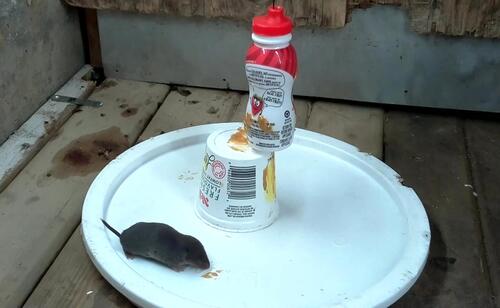 The first challenge was just an inverted yogurt cup with some peanut
butter on it and a plastic bottle suspended above it so it would have
to be bumped out of the way.
The first challenge was just an inverted yogurt cup with some peanut
butter on it and a plastic bottle suspended above it so it would have
to be bumped out of the way.
The first creature that showed up was a shrew. Initially I thought I might end up with another mouse vs. shrew themed video. But the shrew only showed up a few times and never did anything interesting.
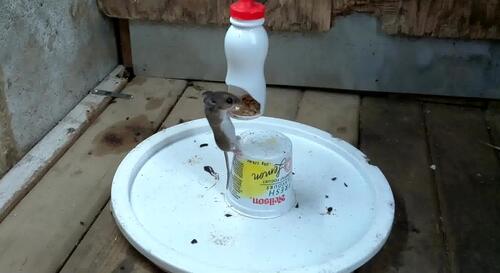 A little mouse showed up. It also didn't try too hard to get at the food.
But the problem was, I started this at the beginning of October 2019, when
outside food for rodents is still relatively abundant.
A little mouse showed up. It also didn't try too hard to get at the food.
But the problem was, I started this at the beginning of October 2019, when
outside food for rodents is still relatively abundant.
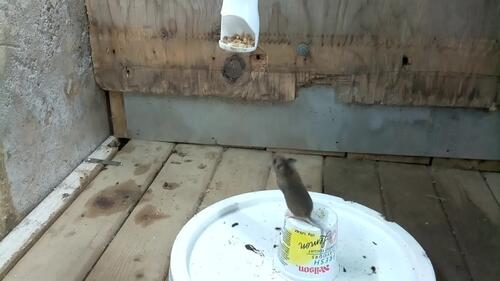 As it got colder, the mouse was willing to try harder to get
the food. Here I have the plastic bottle cut open, with food on
the bottom of it. The mouse is ready to take a leap at it.
As it got colder, the mouse was willing to try harder to get
the food. Here I have the plastic bottle cut open, with food on
the bottom of it. The mouse is ready to take a leap at it.
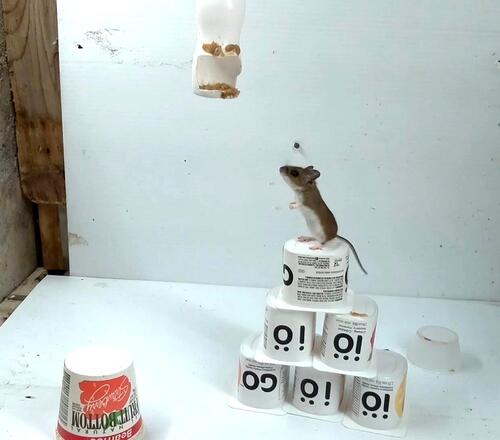 From my mouse trap experiment I
knew mice could jump up to 30 cm high, but this mouse wasn't prepared to
jump higher than 20 cm. Maybe escaping from a bucket trap was a stronger
motivator than just getting at food.
From my mouse trap experiment I
knew mice could jump up to 30 cm high, but this mouse wasn't prepared to
jump higher than 20 cm. Maybe escaping from a bucket trap was a stronger
motivator than just getting at food.
So I experimented with more interesting jumping off point. The mouse was happy to jump off a stack of yogurt cups, but as the stack partially collapsed, it wasn't successful at getting at the food anymore.
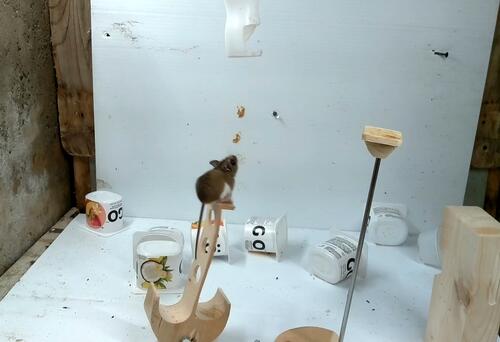
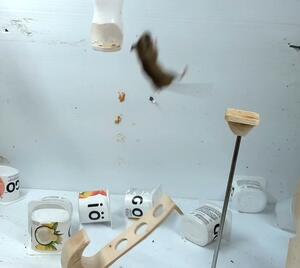 Next jumping off point, a very tippy slef-righting sort of platform.
Here the mouse is eyeing the target, then takes a jump.
Next jumping off point, a very tippy slef-righting sort of platform.
Here the mouse is eyeing the target, then takes a jump.
But this is a very wobbly platform, which makes it difficult to hit the target. The platform moved too much to the side during the takeoff jump, messing up the mouse's aim.
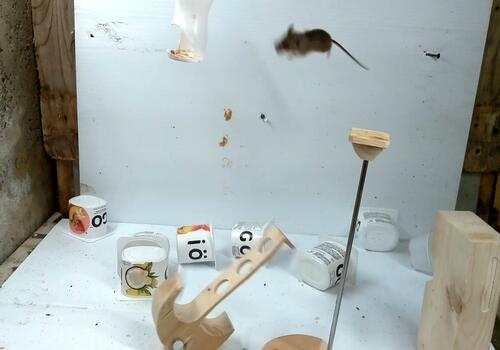 Here's another jump off this platform. A really bad takeoff. The mouse is
actually travelling left to right, but spinning as it flew.
Here's another jump off this platform. A really bad takeoff. The mouse is
actually travelling left to right, but spinning as it flew.
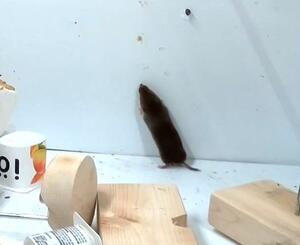 Though the shrew totally owned my hole experiment
and big maze experiment, if it had stuck around,
it would have been totally out of its league here. With short legs and
very poor eyesight, this sort of jump would not have been possible for
the shrew. I'm quite amazed at what the mouse was able to do.
Though the shrew totally owned my hole experiment
and big maze experiment, if it had stuck around,
it would have been totally out of its league here. With short legs and
very poor eyesight, this sort of jump would not have been possible for
the shrew. I'm quite amazed at what the mouse was able to do.
But the shrew returned much later (at right) but it only sniffed at things. I don't think shrews jump or climb much.
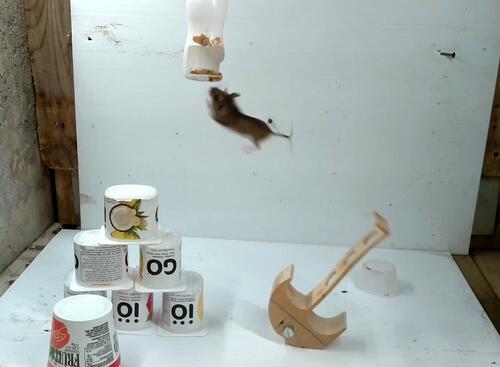
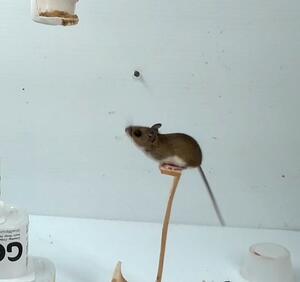 Another attempt, this jump was too low.
Another attempt, this jump was too low.
I should add, the mouse was able to aim for the target surprisingly well, but I kept more clips of it missing the target.
I had the camera running continuously from the beginning of October 2019 to mid January 2020, but my software discarded over 99.8% of the clips on the spot. I did have a few gaps in recording from revising the software mid-way and introducing bugs. These experiments always involve some amount of programming.
The mouse typically showed up for about 20 minutes a night, but some nights not at all, and sometimes during the day.
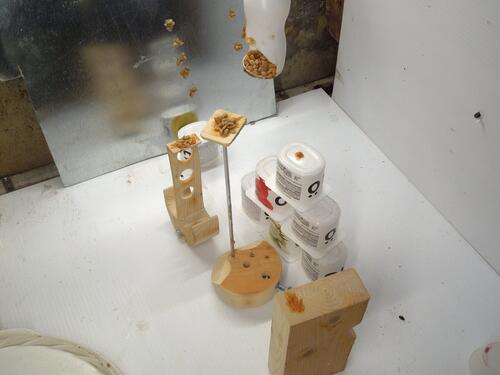 I kept modifying the experiment, trying to make things more interesting.
Here's a food platform on a metal rod pedestal, on a base that is round on the
bottom to make it wobbly. I hoped the mouse couldn't climb the rod, but it
had no problem getting up. So this pedestal ended up mostly serving as
a wobbly jumping-off platform.
I kept modifying the experiment, trying to make things more interesting.
Here's a food platform on a metal rod pedestal, on a base that is round on the
bottom to make it wobbly. I hoped the mouse couldn't climb the rod, but it
had no problem getting up. So this pedestal ended up mostly serving as
a wobbly jumping-off platform.
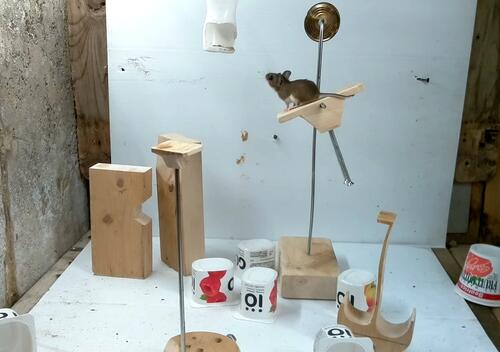
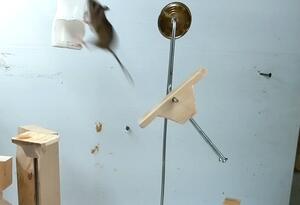 I created a teeter-totter platform, with screws in the bottom to weigh it.
It's on an odd shaped metal rod stand, with a big washer on the rod to
try to keep the mouse from climbing up the rod to get to it.
I created a teeter-totter platform, with screws in the bottom to weigh it.
It's on an odd shaped metal rod stand, with a big washer on the rod to
try to keep the mouse from climbing up the rod to get to it.
The mouse was surprisingly good at jumping off the wobbly teeter totter.
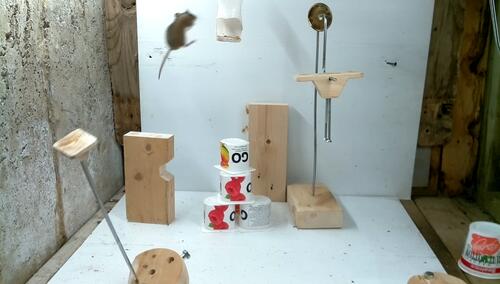 The mouse was also willing to jump a considerable distance horizontally
off the tall wobbly platform (tipping away from the recoil). The tall
wobbly platform was a relatively better jumping off point due to its
mass from the metal rod.
The mouse was also willing to jump a considerable distance horizontally
off the tall wobbly platform (tipping away from the recoil). The tall
wobbly platform was a relatively better jumping off point due to its
mass from the metal rod.
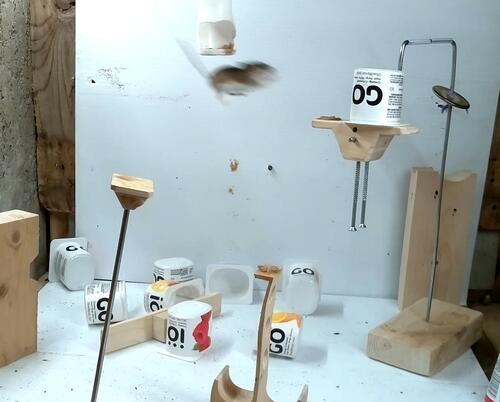 Mouse in mid air. The mouse jumped from the piece of wood at left, but
the trajectory was too low to hit the food container.
Mouse in mid air. The mouse jumped from the piece of wood at left, but
the trajectory was too low to hit the food container.
It was a fun experiment to run, every morning checking if the mouse
had visited see if it tried to do anything interesting. Mice normally
live very secretive lives, and to see what it had been up to in full
color high definition!
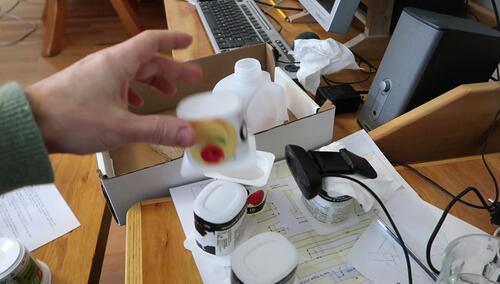 There wasn't any ultimate conclusion to this one, but by mid January I
figured I had enough to edit into an interesting video.
There wasn't any ultimate conclusion to this one, but by mid January I
figured I had enough to edit into an interesting video.
But my setup didn't capture sound. And even if it did, it wouldn't have been that interesting. So after spending much time selecting which clips to use came the long work of adding sounds for everything. I had a mess of plastic containers, scraps of wood, and various kitchen utensils on my desk that I used to make mostly believable sound effects to go along with the action.
This effort is justifiable if the resulting video gets millions
of views, but whether it will is always a gamble. Some of my past
mouse videos did much better than I hoped fir, but past success is no
guarantee of future success. Views of my old mouse videos
have declined quite a lot since early 2019, so I have doubts
but I figured I'd give it another try. You never know.
I'll keep feeding this mouse for a while longer so it will be there for
another experiment, if I feel like it and not disappear on me like with
this experiment. I suspect what happened
there is that mouse didn't make it through the winter for lack of enough
food. The mouse isn't in the house. If they were, I'd have much less
interest in keeping it alive
Update 2022
My earlier mouse videos got millions of views, but this one did not do very well, even though technically I felt it was my best mouse video yet.
Perhaps it was too slow paced, or lacked "story". but I thought I'd give it another try as a YouTube #shorts video, edited down to just one minute. My YouTube Shorts videos have all done well in terms of getting a good number of views. I'ts too bad the "shorts" views don't earn any money, though they do earn a little when viewed as a regular video.
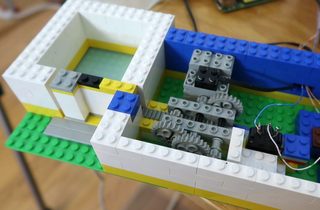 Mouse experiment setup vlog (2018)
Mouse experiment setup vlog (2018)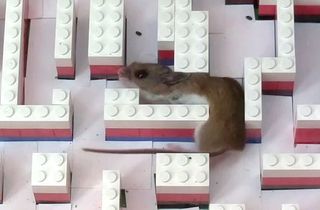 Mouse in a lego maze (2019)
Mouse in a lego maze (2019)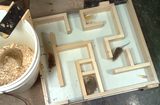 Mouse trap maze experiments (2016)
Mouse trap maze experiments (2016)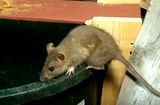 Rat trap fail (2016)
Rat trap fail (2016)